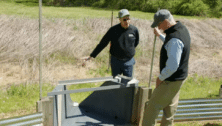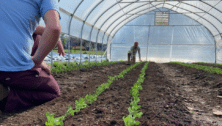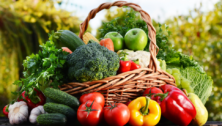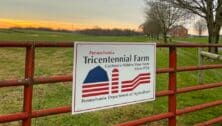Chester County Ag Notes: A Quart of Milk History

By Duncan Allison
Dairy has played an important role in farming since the middle of the 19th century when cattle took over from wheat as the main farming enterprise in Chester county and region. The productive meadows supported 50,000 cattle in 1860 which supplied the nearby Philadelphia and suburbs with milk (and butter) and beef.
The increasing local demand from Philadelphia and suburbs stimulated farmers to increase production. They found that better feed and shelter could increase both milk yields and meat production.
During the second half of the 19th century dairy cattle breeds with higher milk production were introduced from North Europe – Shorthorns, Ayrshires and Holstein Friesians. Today those big black and white Holsteins are the dominant dairy breed (around 90%) and their milk with lower fat content suits current consumer preference.
A few of our farmers prefer Ayrshires, Shorthorns and Jersey cattle for their higher butter fat milk for cheese and yogurt production.
Holstein Friesians weigh 1,400 lbs. at maturity and produce 75 lbs. or almost 9 gallons of milk each day. The average annual yield of a dairy cow in Pennsylvania is just over 20,000 lbs. Compare this to the almost 10x increase over the 2,371 lbs. in 1850.
22 million dairy cows were needed to meet milk needs in the 1940s whereas today our national dairy herd of around 9 million dairy cows produces enough milk for our 300 million population and 13% is exported. Our 275 Chester County dairy farmers produce sufficient milk for our almost 500,000 residents and over 200,000 people in nearby counties and states.
Today huge emphasis is placed not only on feed and shelter but also on breeding and cow comfort. Each dairy cow requires 30-40 gallons of water and over 40 lbs. of feed each day.
The feed must also be carefully balanced to provide a total mixed ration including forages, grains, protein feeds such as soybean meal, minerals and vitamins. Our local dairy farmers typically produce 60-70% of their own forage feed but need to buy protein, minerals and vitamins.
Feed represents 45-65% of their total dairy costs. Many dairy farmers use nutrition consultants to ensure the feed is correct. A plentiful supply of clean water must also be available.
Many if not most of our dairy farmers keep their cows in barns. This is not only necessary because of the long winters and lack of pasture grazing but also because of summer heat. You will have seen dairy cows huddled under any shade trees during hot summer days.
In barns big fans are installed and a sprinkler system provides evaporative water on their backs to keep them cooler. There is concern that climate change with higher summer temperatures may exacerbate the situation as cows can die when their body temperature rises 3 or 4 degrees above their normal 101.5 F.
Cow comfort is also critical and cows require a comfortable base in the barn to lie on when they spend time chewing the cud – up to ten hours a day. Sand, straw and even rubber mats are used to provide a clean, dry resting surface.
Milking is normally twice each day and milking parlors vary in design depending on the scale of the operation. Hand milking used to take 10-15 minutes per cow but machine milking is now standard and takes less than 5 minutes.
There are even robotic milkers available when cows are able to manage their own schedule. Modern milk distribution is highly developed and extensive research has shown that it takes milk only 48 hours to travel from farm to the grocery store.
There is no way to cover all the many aspects of dairy production so a further article will cover milk safety and pasteurization, the complicated monthly pricing of milk, breeding procedures and the dynamic Chester County dairy farmers who are making award winning artisan cheeses.
_________
 Duncan Allison gained degrees in horticulture and extension education in the UK and US and spent most of his career working for the DuPont Company developing and marketing crop protection chemicals. Recently he has written reports for a global ag publisher and for New Jersey-based international business consultants Kline & Co. For the last 16 years he has been heavily involved in the local farming of Chester County where he has lived with his wife and family since 1980.
Duncan Allison gained degrees in horticulture and extension education in the UK and US and spent most of his career working for the DuPont Company developing and marketing crop protection chemicals. Recently he has written reports for a global ag publisher and for New Jersey-based international business consultants Kline & Co. For the last 16 years he has been heavily involved in the local farming of Chester County where he has lived with his wife and family since 1980.
Connect With Your Community
Subscribe to stay informed!
"*" indicates required fields























![95000-1023_ACJ_BannerAd[1]](https://vista.today/wp-content/uploads/2023/03/95000-1023_ACJ_BannerAd1.jpg)

























